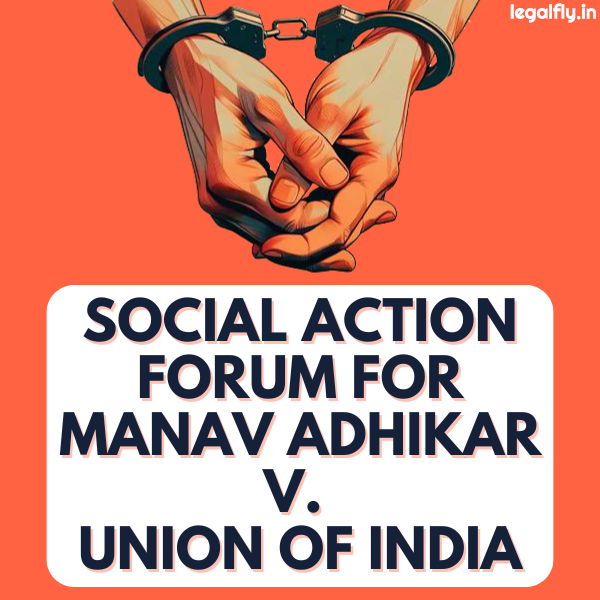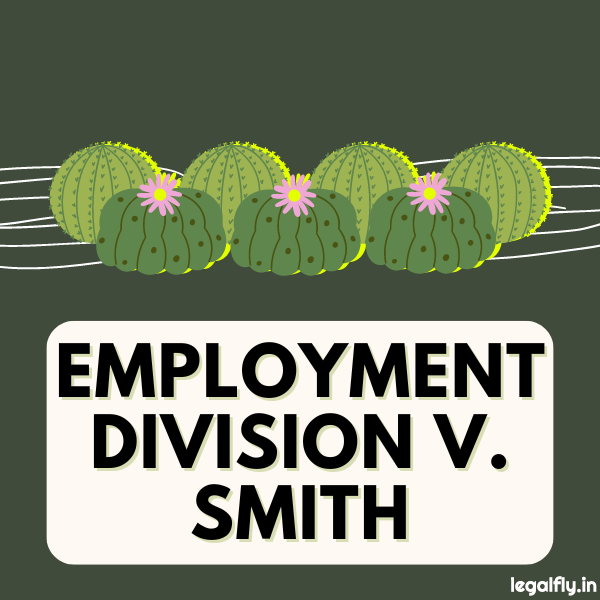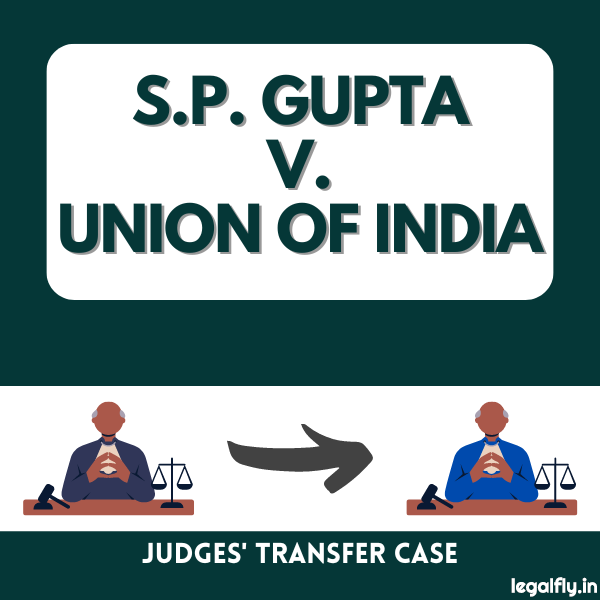Table of Contents
Case Name: Social Action Forum for Manav Adhikar v. Union of India
Court: Supreme Court of India
Year: 2018
Citation: (2018) 10 SCC 443
Introduction to the Case
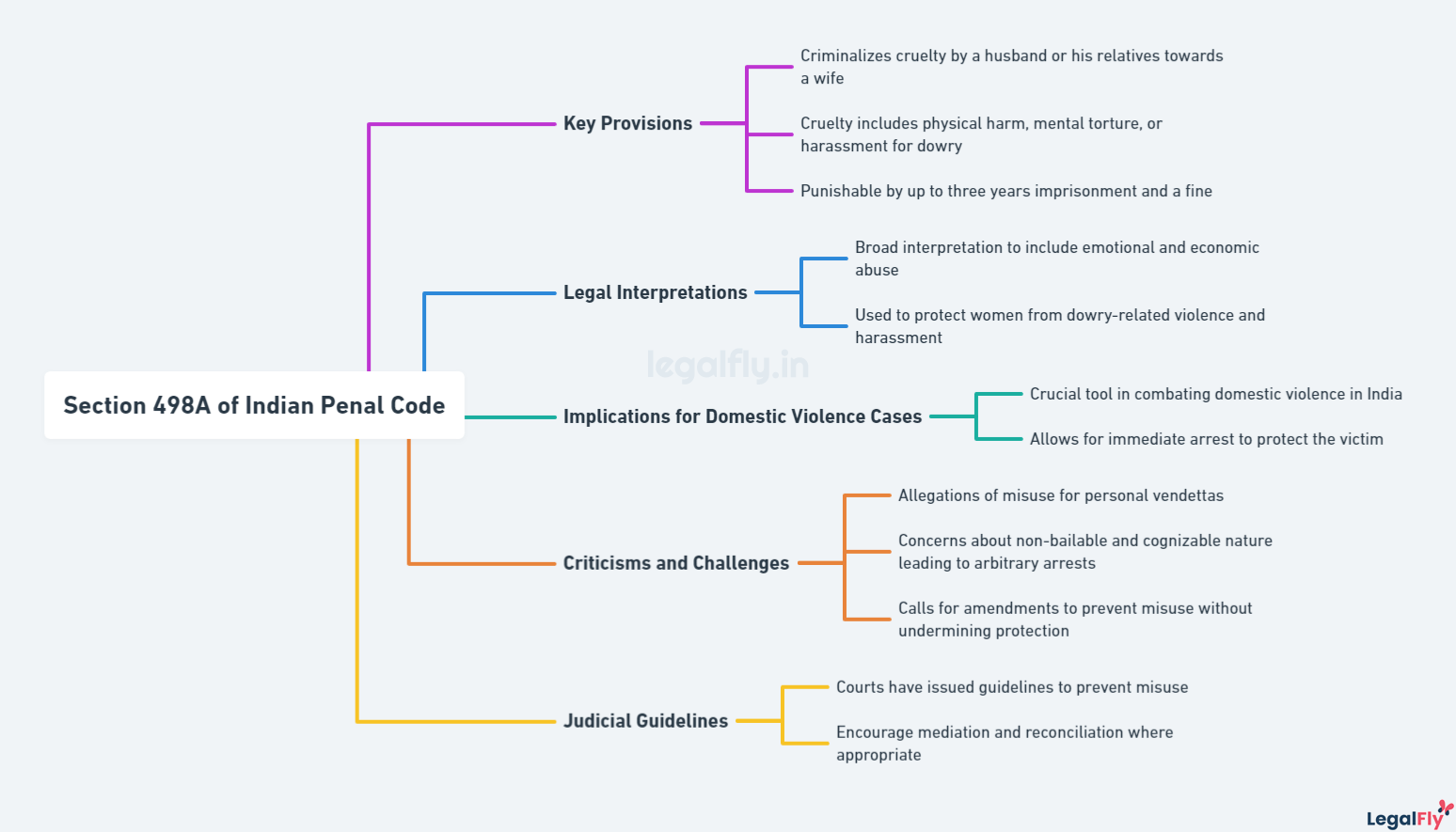
Section 498A of the Indian Penal Code, which deals with cruelty against married women by husbands and relatives, has been controversial due to allegations of its misuse and instances of false complaints. In light of this, the petitioners, Social Action Forum for Manav Adhikar, filed a writ petition in 2018 against the Union of India, Ministry of Home Affairs and Ministry of Law and Justice. The petitioners argued that Section 498A was being misused, leading to the violation of fundamental rights of individuals. They sought the creation of an enabling mechanism to curb false and frivolous complaints. The Social Action Forum for Manav Adhikar v. Union of India case arose amidst increasing concerns over the misuse of dowry harassment laws.
Background and Context
The Social Action Forum for Manav Adhikar petition was filed against the backdrop of increasing concerns over the misuse of Section 498A IPC. Section 498A, which deals with cruelty against married women, was introduced in 1983 to protect women from domestic violence and harassment over dowry demands. However, over the years, there have been many instances where disgruntled wives have used this provision to implicate husbands and their relatives in petty marital disputes without adequate evidence of cruelty.
Prior Supreme Court judgments, like Sushil Kumar Sharma v. Union of India (2005), had observed that Section 498A was being used as a “weapon rather than a shield” by disgruntled wives. The Court had directed the government to amend the law to prevent such misuse. However, no amendments were made. Subsequent judgments in Arnesh Kumar v. State of Bihar (2014) and Rajesh Sharma v. State of U.P (2017) tried to introduce guidelines to check arbitrary arrests under Section 498A complaints. However, the implementation was ineffective.
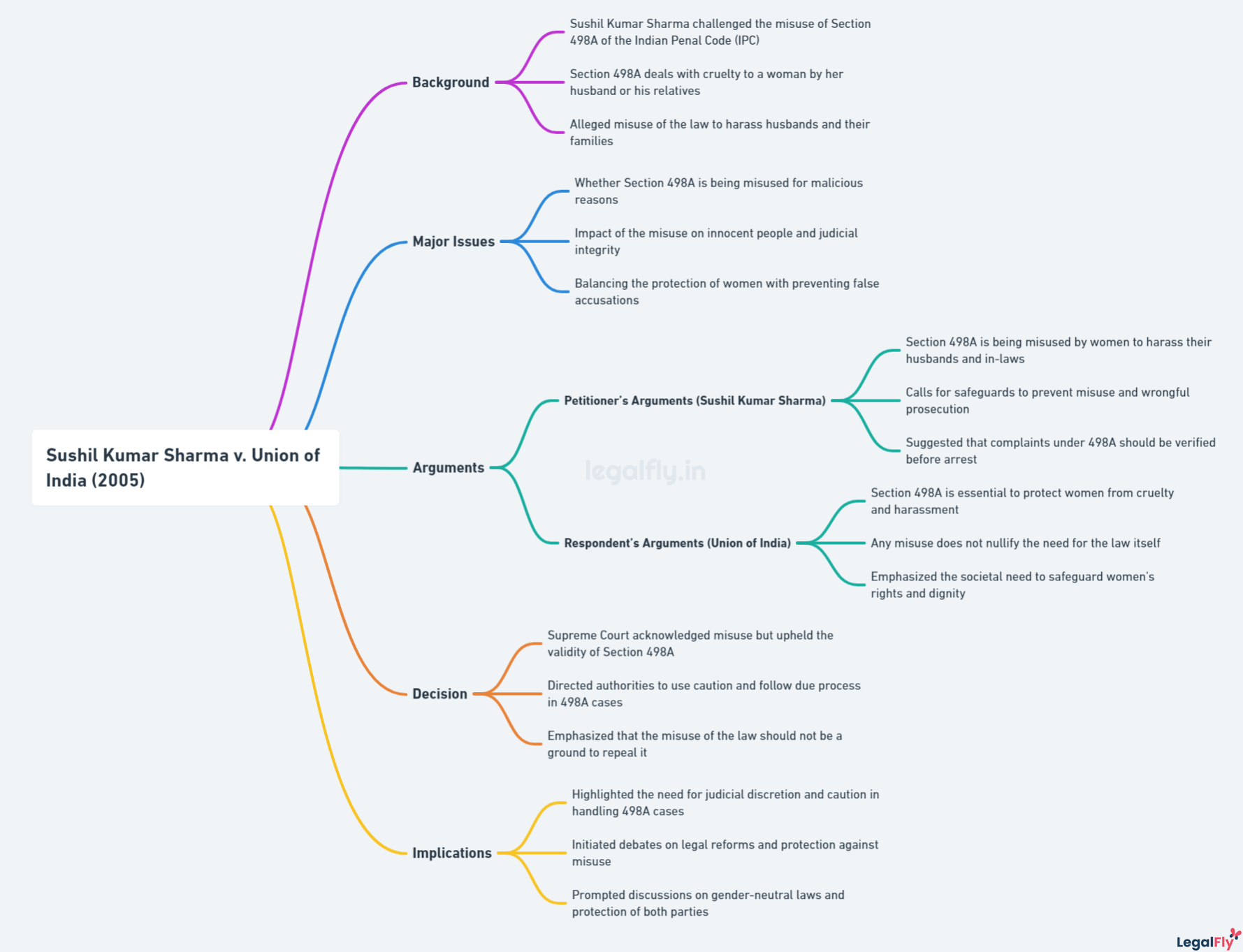
This led to the filing of the Social Action Forum petition in 2017, seeking definitive guidelines and directions from the Supreme Court to control the abuse of Section 498A and protect citizens from unjust arrests and harassment. An authoritative ruling was needed to balance the rights of married women as well as innocent citizens and prevent the misuse of criminal law.
Legal Issues Addressed
In the Social Action Forum for Manav Adhikar v. Union of India case, the Supreme Court noted concerns that Section 498A IPC was being increasingly misused to harass husbands and their relatives. There was a growing trend of the section being invoked to “wreak vengeance” and extort money without adequate evidence of cruelty.
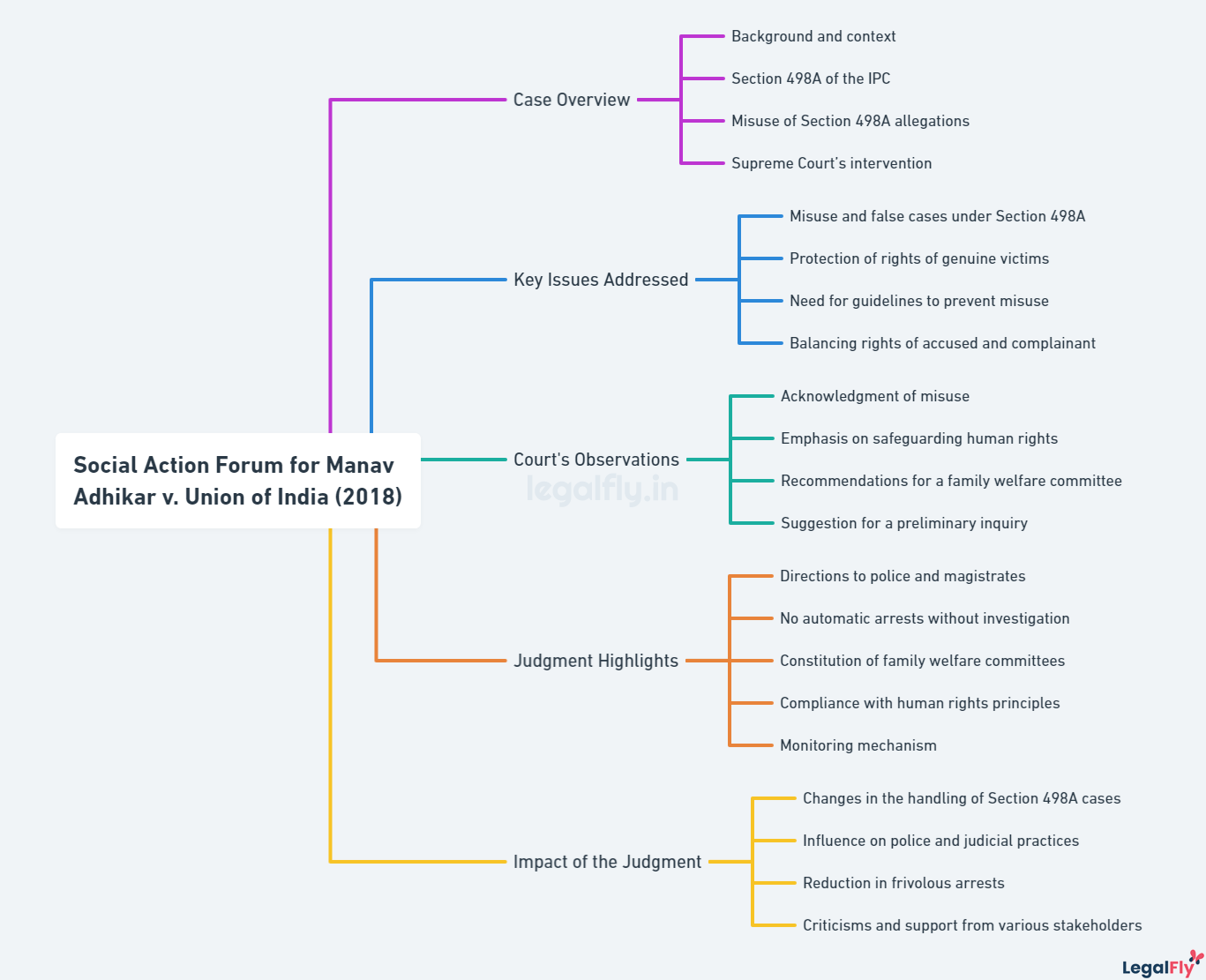
Previous judgments, such as Arnesh Kumar v. State of Bihar, had attempted to address this issue by directing police not to arrest those accused under Section 498A automatically. However, abuse of the law continued.
The Supreme Court aimed to strike a balance between protecting the rights of married women suffering cruelty while also preventing the misuse of Section 498A for settling personal vendettas. An important question under the section was what role the police and judiciary should play in curbing false complaints. The judgment in the Social Action Forum for Manav Adhikar v. Union of India case provided directives to address these concerns.
Supreme Court’s Guidelines and Directions
In the Social Action Forum for Manav Adhikar v. Union of India case, the Supreme Court provided comprehensive guidelines and directions to prevent the misuse of Section 498A while protecting the rights of married women. The key aspects included:
Establishment of Family Welfare Committees
The Court directed all state governments to establish Family Welfare Committees (FWCs) in each district to receive complaints of cruelty under Section 498A. The FWCs would comprise para-legal volunteers, social workers, and retired persons and settle disputes through counselling and mediation. Their role was to screen complaints before any arrests were made under Section 498A.
Conditions for Arrest Under Section 498A
The Court ruled that arrests should not be automatic under Section 498A and specified conditions that must be met before an arrest:
- Complaints under Section 498A will be referred to FWCs. Arrests will be made only if the FWC submits a report recommending police action.
- Police officers should be designated as investigating officers in Section 498A cases. They must ensure that no unjustified arrests are made.
- Arrests can be made only if the accused is likely to tamper with evidence or influence witnesses.
- In cases of domestic disputes with no injuries, the police must first issue notice to the accused before arresting them.
Role of Police and Judicial Authorities
The Court directed police and judicial magistrates to closely examine cases under Section 498A. Chargesheets must contain adequate justification for immediate arrests. The Court also ruled that bail should be granted liberally in such cases to prevent innocent persons from languishing in jail.
Supreme Court’s Decision
In the Social Action Forum for Manav Adhikar v. Union of India case, the Supreme Court upheld the constitutional validity of Section 498A IPC while issuing guidelines to curb its misuse and prevent arbitrary arrests. The Court found that Section 498A was enacted to protect women from cruelty in matrimonial homes, and the mere possibility of abuse cannot invalidate it. However, reports of exaggerated allegations in several cases called for safeguards against arbitrary arrests.
The Court ruled that Family Welfare Committees should review complaints before arrests are made. This limited police powers and increased judicial oversight. The Court directed the police not to automatically arrest the accused and magistrates not to automatically remand the accused to custody without due application of mind.
Overall, the judgment balanced protections for women with safeguards against misuse. It upheld Section 498A while introducing guidelines to ensure fairness in its implementation. The Court aimed to prevent arbitrary arrests while preserving the law’s purpose of protecting married women from cruelty.
Implications of the Judgment
The landmark judgment in the Social Action Forum for Manav Adhikar v. Union of India case had significant implications for the application of Section 498A IPC. It affected police procedures and requirements for arrest, as well as the conduct of trials under this section.
Effect on Future Section 498A Cases
The guidelines laid down by the Supreme Court reshaped the investigative and prosecution process in cases filed under Section 498A IPC. Police were required to follow due process, conduct proper investigations and avoid indiscriminate arrests. This reduced the ability to use the law for harassment or vengeance. However, it also made it more challenging for genuine victims to get timely redressal.
Overall, the judgment necessitated a balanced approach by ensuring fair treatment and protection of rights for both accused and complainants in dowry harassment cases. It aimed to curb misuse without diluting the law’s intention to protect women from cruelty.
Influence on Legal Protection for Women
The judgment received criticism from women’s rights activists who felt it would weaken the deterrent effect of Section 498A and embolden abusers. Concerns were raised that setting up Family Welfare Committees and limiting arrests would discourage victims from filing complaints.
However, the Court clarified that the law remained intact to penalize cruelty to married women. The guidelines aimed to prevent innocent people from harassment while preserving the law’s constitutional validity. Nevertheless, implementation gaps persist, underscoring the need for police training and sensitization.
Broader Social and Legal Consequences
The Social Action Forum for Manav Adhikar v. Union of India case had far-reaching consequences. It led to stricter scrutiny of complaints under Section 498A, thereby reducing the number of cases filed. Some critics perceived this as a setback to women’s rights. However, the Court reiterated that the judgment should not deter genuine complaints.
The case also influenced the framing of anti-dowry legislation such as the Protection of Women from Domestic Violence Act 2005. It highlighted the need for a broader social movement against dowry itself. Overall, the judgment shaped the modern application of criminal law to balance the protection of rights with the prevention of misuse.
Ongoing Relevance and Implementation
The guidelines issued by the Supreme Court in the Social Action Forum for Manav Adhikar v. Union of India case remain relevant in the contemporary legal context. The judgment set important precedents on balancing protections for women while preventing the misuse of Section 498A IPC. However, the implementation of the guidelines has been uneven.
Police and judicial authorities’ compliance with the guidelines has been mixed across different states in India. There are reports that arrests under Section 498A still occur without adequate verification or in violation of the prescribed procedures. At the same time, the guidelines have led to more responsible police conduct in some jurisdictions.
The judgment has been frequently cited in subsequent cases dealing with the misuse of Section 498A IPC and the need to verify allegations before making arrests. In Arnesh Kumar v. State of Bihar (2014), the Supreme Court reinforced the safeguards prescribed in this case while ruling on the powers of police to make arrests under Section 498A.
While upholding the validity of Section 498A, courts have emphasized adhering to the Social Action Forum guidelines as a way to balance the objectives of women’s protection and prevention of misuse. Thus, the judgment remains highly relevant for defining the processes to be followed in dowry harassment cases under Section 498A IPC. However, concerns persist about compliance and consistent implementation across different states.
Criticisms and Challenges
The judgment in the Social Action Forum case has faced criticism on several fronts. Some activists and women’s rights groups have argued that the guidelines excessively curtail the scope of Section 498A IPC and make it more difficult for victims of dowry harassment to seek legal recourse. They contend that establishing Family Welfare Committees creates additional bureaucratic hurdles before victims can file complaints. There are also concerns that perpetrators may exert influence over the committees to avoid prosecution.
Further, the conditionalities imposed on arrests are seen as diluting the deterrent effect of Section 498A. Some argue this exposes women to potential harassment and violence from accused relatives who are not promptly arrested. There have been challenges in the effective enforcement of guidelines by police authorities in several states. The lack of monitoring mechanisms makes it difficult to ensure compliance, leading to arbitrary application.
Overall, critics contend the judgment excessively focuses on preventing misuse at the cost of compromising legal protections for genuine victims of dowry harassment. They argue that women’s rights cannot be contingent on preventing misuse, as the fundamental right to life and dignity must take precedence. More balanced implementation of the safeguards, along with educational programs, is needed.
Conclusion
The Social Action Forum for Manav Adhikar v. Union of India case was a landmark judgment by the Supreme Court regarding the interpretation and implementation of Section 498A IPC. The Court aimed to strike a balance between protecting the rights of married women facing cruelty and preventing the misuse of this provision.
The key takeaways from the judgment include:
- The Court upheld the constitutionality of Section 498A IPC and acknowledged the need to punish cruelty against women. However, guidelines were issued to curb false or exaggerated accusations.
- Under Section 498A, Family Welfare Committees were established to vet complaints before arrests are made. This aimed to prevent arbitrary arrests based on unverified charges.
- Conditions were imposed for making arrests, such as requiring approval from senior police officers and establishing a prima facie case. This restricted police powers to indiscriminately arrest accused persons.
- The misuse of the provision was attributed to police and prosecutors rather than the law itself. Hence, the Court directed proper implementation.
While the guidelines have reduced arbitrary arrests, concerns remain about declining convictions and compromised protections for victims. Further legal reforms are needed to ensure justice for all parties. The judgment reflects the complex balancing act between women’s rights and preventing harassment of innocent individuals that continues to challenge India’s legal system.
Frequently Asked Questions
Some critical questions related to the impact and significance of the Social Action Forum for Manav Adhikar v. Union of India case:
What was the outcome of the Social Action Forum for Manav Adhikar v. Union of India case?
The Supreme Court issued several guidelines to prevent the misuse of Section 498A IPC while also upholding the law’s validity. The Court directed setting up Family Welfare Committees to review complaints and specified conditions for arrest. Police were barred from making automatic arrests and required magistrates’ approval.
How did the judgment affect arrest procedures in dowry harassment cases?
The judgment mandated approval of arrest from magistrates and restricted police powers for immediate arrest under Section 498A. This aimed to prevent arbitrary arrests before ascertaining the complaints’ veracity.
What are the implications for Section 498A IPC cases?
The guidelines increased scrutiny of complaints to balance women’s rights while preventing misuse. Complainants now face more burden to prove accusations. Some argue this diluted protection, while others say it curbs false complaints.

